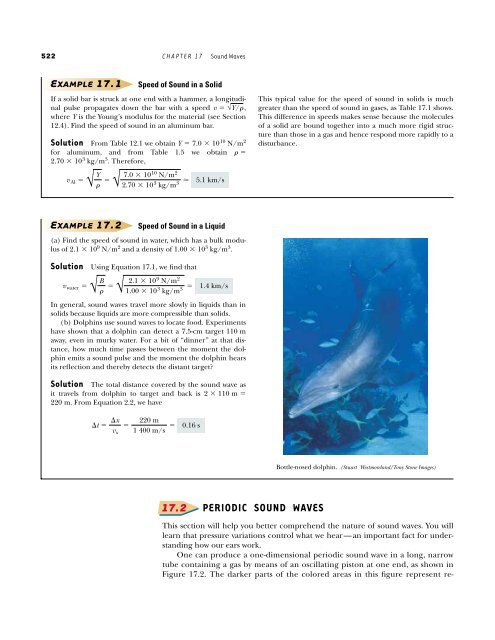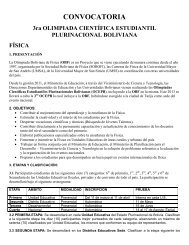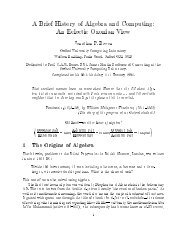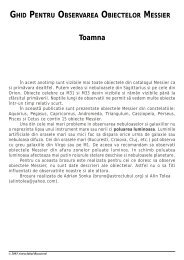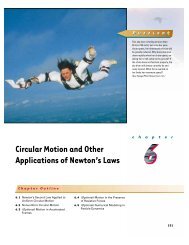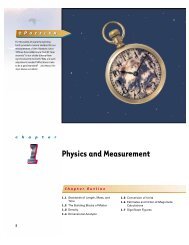You also want an ePaper? Increase the reach of your titles
YUMPU automatically turns print PDFs into web optimized ePapers that Google loves.
522 CHAPTER 17 <strong>Sound</strong> <strong>Waves</strong><br />
EXAMPLE 17.1<br />
Speed <strong>of</strong> <strong>Sound</strong> in a Solid<br />
If a solid bar is struck at one end with a hammer, a longitudinal<br />
pulse propagates down the bar with a speed v � !Y/� ,<br />
where Y is the Young’s modulus for the material (see Section<br />
12.4). Find the speed <strong>of</strong> sound in an aluminum bar.<br />
Solution From Table 12.1 we obtain<br />
for aluminum, and from Table 1.5 we obtain<br />
2.70 � 10 Therefore,<br />
3 kg/m3 Y � 7.0 � 10<br />
.<br />
10 N/m2 v Al � ! Y<br />
EXAMPLE 17.2<br />
� � ! 7.0 � 1010 N/m 2<br />
2.70 � 10 3 kg/m<br />
3 �<br />
17.2<br />
5.1 km/s<br />
Speed <strong>of</strong> <strong>Sound</strong> in a Liquid<br />
� �<br />
(a) Find the speed <strong>of</strong> sound in water, which has a bulk modulus<br />
<strong>of</strong> 2.1 � 10 9 N/m 2 and a density <strong>of</strong> 1.00 � 10 3 kg/m 3 .<br />
Solution Using Equation 17.1, we find that<br />
v water � ! B<br />
� � ! 2.1 � 109 N/m 2<br />
In general, sound waves travel more slowly in liquids than in<br />
solids because liquids are more compressible than solids.<br />
(b) Dolphins use sound waves to locate food. Experiments<br />
have shown that a dolphin can detect a 7.5-cm target 110 m<br />
away, even in murky water. For a bit <strong>of</strong> “dinner” at that distance,<br />
how much time passes between the moment the dolphin<br />
emits a sound pulse and the moment the dolphin hears<br />
its reflection and thereby detects the distant target?<br />
Solution The total distance covered by the sound wave as<br />
it travels from dolphin to target and back is 2 � 110 m �<br />
220 m. From Equation 2.2, we have<br />
�t � �x<br />
v x<br />
1.00 � 10 3 kg/m<br />
�<br />
220 m<br />
1 400 m/s �<br />
3 �<br />
0.16 s<br />
1.4 km/s<br />
This typical value for the speed <strong>of</strong> sound in solids is much<br />
greater than the speed <strong>of</strong> sound in gases, as Table 17.1 shows.<br />
This difference in speeds makes sense because the molecules<br />
<strong>of</strong> a solid are bound together into a much more rigid structure<br />
than those in a gas and hence respond more rapidly to a<br />
disturbance.<br />
PERIODIC SOUND WAVES<br />
Bottle-nosed dolphin. (Stuart Westmoreland/Tony Stone Images)<br />
This section will help you better comprehend the nature <strong>of</strong> sound waves. You will<br />
learn that pressure variations control what we hear—an important fact for understanding<br />
how our ears work.<br />
One can produce a one-dimensional periodic sound wave in a long, narrow<br />
tube containing a gas by means <strong>of</strong> an oscillating piston at one end, as shown in<br />
Figure 17.2. The darker parts <strong>of</strong> the colored areas in this figure represent re-


